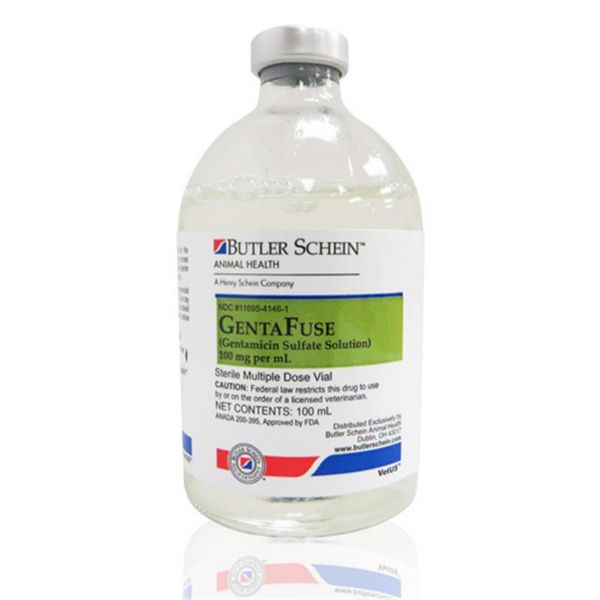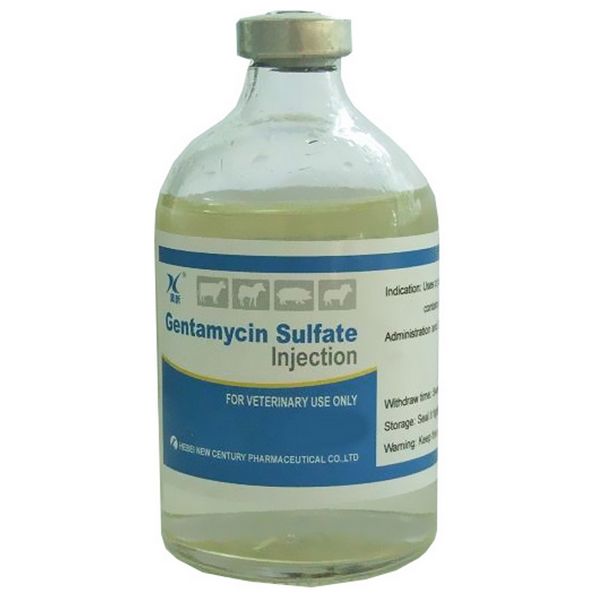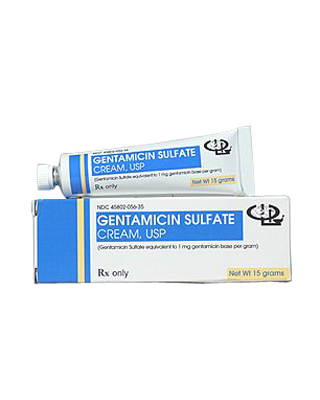Gentamicin is an aminoglycoside antibiotic.

Administration
Gentamicin sulfate is administered by IM injection or IV infusion.
The drug also has been administered without preservatives intrathecally or intraventricularly to supplement IM or IV administration in the treatment of CNS infections; however, an injectable gentamicin preparation without preservatives for intrathecal use no longer is commercially available in the US. For adults, IV infusions are prepared by diluting the calculated dose of gentamicin with 50-200 mL of 0.9% sodium chloride or 5% dextrose injection.
The diluted solution should be infused over 30 minutes to 2 hours. ADD-Vantage® vials of the drug should be diluted according to the manufacturer’s labeling.
Alternatively, commercially available injections for IV infusion that do not require dilution may be used. When one of these commercially available infusions or an ADD-Vantage® infusion is used, the accompanying labeling should be consulted for proper methods of administration and associated precautions.
Commercially available plastic containers of the drug should be removed from their overwraps according to the manufacturers’ directions and checked for minute leaks by firmly squeezing the bags. The injections should be discarded if the containers’ seals are not intact or leaks are found; however, opacity of the plastic containers usually does not affect the solutions. Additives should not be introduced into the injection container.
Commercially available injections of the drug in 0.9% sodium chloride should be inspected visually for particulate matter and discoloration prior to administration whenever solution and container permit.
The injections should not be used in series connections with other plastic containers, since such use could result in air embolism from residual air being drawn from the primary container before administration of fluid from the secondary container is complete. Once these injection containers have been opened, unused portions of the solutions should be discarded. For pediatric patients, the volume of infusion fluid depends on the patient’s needs, but should be sufficient to allow a gentamicin infusion period of 30 minutes to 2 hours.
Dosage
Dosage of gentamicin sulfate is expressed in terms of gentamicin.

IM and IV dosage is identical and should be based on an estimate of ideal body weight.
The usual IM or IV dosage of gentamicin recommended by the manufacturers for adults with normal renal function is 3 mg/kg daily given in equally divided doses at 8-hour intervals.
The manufacturers state that in life-threatening infections up to 5 mg/kg may be administered daily in 3 or 4 equally divided doses; dosage should be reduced to 3 mg/kg daily as soon as clinically indicated.
Children may receive 6-7. mg/kg daily given in equally divided doses at 8-hour intervals. Infants and neonates should receive 7.5 mg/kg daily given in equally divided doses at 8-hour intervals; premature or full-term neonates 1 week of age or less should be given 2.5 mg/kg every 12 hours.
Alternatively, many clinicians recommend that gentamicin dosage be determined using appropriate pharmacokinetic methods for calculating dosage requirements and patient-specific pharmacokinetic parameters (e.g., elimination rate constant, volume of distribution) derived from serum concentration-time data; in determining dosage, the susceptibility of the causative organism, severity of infection, and the patient’s immune and clinical status also must be considered.
Current evidence suggests that once-daily administration of aminoglycosides is at least as effective as, and may be less toxic than, conventional dosage regimens employing multiple daily doses of the drugs; however, additional controlled studies in children, patients with renal dysfunction, and other appropriate patient groups are needed to fully define the optimal use of once-daily aminoglycoside dosing regimens.
Whenever possible, and especially in patients with life-threatening infections, suspected toxicity or nonresponse to treatment, decreased or varying renal function, and/or when increased aminoglycoside clearance (e.g., patients with cystic fibrosis, burns) or prolonged therapy is likely, peak and trough serum concentrations of gentamicin should be determined periodically and dosage should be adjusted to maintain desired serum concentrations.
A causal relationship between maintenance of certain peak or trough serum concentrations or other pharmacodynamic endpoints and clinical response or toxicity has not been established to date for aminoglycoside dosing regimens. However, in general, desirable peak serum concentrations of gentamicin are 4-12 mcg/mL, and trough concentrations of the drug should not exceed 1-2 mcg/mL.
Some evidence suggests that an increased risk of toxicity may be associated with prolonged peak serum gentamicin concentrations greater than 10-12 mcg/mL and/or trough concentrations greater than 2 mcg/mL.
Prophylaxis of Bacterial Endocarditis
When selecting anti-infectives for the prevention of bacterial endocarditis, the current recommendations published by the American Heart Association (AHA) should be consulted.
For prophylaxis of enterococcal endocarditis in patients at high or moderate risk undergoing certain GI, biliary tract, or genitourinary tract procedures likely to cause transient bacteremia, the AHA and others recommend that most patients receive a 2-dose parenteral regimen that consists of an initial dose of ampicillin given in conjunction with gentamicin.
When this 2-dose regimen is used, the AHA and others recommend that patients receive IM or IV ampicillin (2 g in adults or 50 mg/kg in children) given in conjunction with IM or IV gentamicin (1. mg/kg in adults or children; maximum adult dose 120 mg) administered within 30 minutes of starting the procedure; the second dose administered 6 hours later can consist of IM or IV ampicillin (1 g in adults or 25 mg/kg in children) or, alternatively, oral amoxicillin (1 g in adults or 25 mg/kg in children) given without gentamicin.
For prophylaxis of enterococcal endocarditis in penicillin-allergic patients at high or moderate risk undergoing certain GI, biliary tract, or genitourinary tract procedures, the AHA and others recommend that patients receive IV vancomycin (1 g in adults or 20 mg/kg in children) given in conjunction with IM or IV gentamicin (1. mg/kg in adults or children; maximum adult dose 120 mg) within 30 minutes of starting the procedure; a follow-up dose is not necessary in these patients.
For prophylaxis of bacterial endocarditis in penicillin-allergic patients at risk undergoing GI, biliary, or genitourinary tract surgery or instrumentation, the AHA currently states that adults should receive 1 g of vancomycin given IV over 1 hour beginning 1 hour prior to the procedure and 1.5 mg/kg (up to a maximum dose of 80 mg) of gentamicin given IM or IV 1 hour prior to the procedure and that the doses may be repeated 8 hours later.
Children should receive 20 mg/kg of vancomycin IV over 1 hour and 2 mg/kg of gentamicin IM or IV at the same intervals; pediatric follow-up doses should be one-half the initial dose.
Pediatric dosage should not exceed the adult dosage.
For prophylaxis of bacterial endocarditis in patients at risk who are undergoing GI, biliary, or genitourinary tract surgery or instrumentation, the AHA and many clinicians currently recommend that adults receive 1.5 mg/kg (up to a maximum dose of 80 mg) of gentamicin and 2 g of ampicillin given separately IM or IV 30 minutes prior to the procedure and 1.5 g of oral amoxicillin 6 hours later; children at high risk should receive 2 mg/kg of gentamicin and 50 mg/kg of ampicillin given separately IM or IV 30 minutes prior to the procedure and 25 mg/kg of oral amoxicillin 6 hours later.
Pediatric dosage should not exceed the adult dosage. Alternatively, instead of the oral follow-up dose, the parenteral regimen can be repeated 8 hours later; pediatric follow-up doses should be one-half the initial dose.
Acute Pelvic Inflammatory Disease
For the treatment of acute pelvic inflammatory disease (PID) in hospitalized patients, adolescents and adults with normal renal function may receive an initial IM or IV gentamicin dose of 2 mg/kg followed by 1.5 mg/kg every 8 hours.
Dosage of gentamicin (dose and/or dosing interval) should be adjusted according to serum gentamicin concentrations.
Clindamycin phosphate should be administered IV concomitantly in a dosage of 900 mg (of clindamycin) every 8 hours, and both drugs should be continued IV for at least 24 hours after defervescence.
Clindamycin then should be continued in an oral dosage of 450 mg 4 times (every 6 hours) daily to complete 14 days of therapy.
Plague
For the treatment of plague, including pneumonic plague that occurs as the result of exposure to Yersinia pestis in the context of biologic warfare or bioterrorism, the recommended dosage of gentamicin in adults with normal renal function is 5 mg/kg IM or IV once daily or, alternatively, adults may receive a 2-mg/kg loading dose following by 1.7 mg/kg IM or IV 3 times daily.
For the treatment of pneumonic plague in children, those with normal renal function may receive gentamicin in a dosage of 2.5 mg/kg IM or IV 3 times daily; neonates up to 1 week of age and premature neonates should receive a dosage of 2.5 mg/kg IV twice daily.
The usual duration of therapy for the treatment of plague is 10 days; some experts recommend a duration of 10-14 days.
Tularemia
For the treatment of tularemia that occurs as the result of exposure to Francisella tularensis in the context of biologic warfare or bioterrorism, the US Working Group on Civilian

Biodefense recommends that adults with normal renal function receive a gentamicin dosage of 5 mg/kg IM or IV once daily and that children with normal renal function receive 2.5 mg/kg IM or IV 3 times daily for 10 days; the US Army Medical Research Institute of Infectious Diseases recommends that adults receive 3-5 mg/kg IV daily for 10-14 days.
Dosage in Renal Impairment
In patients with impaired renal function, doses and/or frequency of administration must be modified in response to serum concentrations of the drug and the degree of renal impairment.
There are various methods to determine dosage and a wide variation in dosage recommendations for these patients. However, even when one of these methods is used, peak and trough serum concentrations of the drug should be monitored, especially in patients with changing renal function. The manufacturers recommend an initial dose of 1-1. mg/kg.
For subsequent therapy, the manufacturers state that 1 mg/kg doses can be given at intervals (in hours) calculated by multiplying the patient’s steady-state serum creatinine (in mg/dL) by 8. Alternatively, many clinicians recommend the dosing method of Sarubbi and Hull, which is based on corrected creatinine clearance.
These dosage calculation methods should not be used in patients undergoing hemodialysis or peritoneal dialysis. In patients with renal failure undergoing hemodialysis, the manufacturers recommend supplemental doses of 1-1. mg/kg at the end of each dialysis period in adults and supplemental doses of 2-2. mg/kg at the end of each dialysis period in children.
Pharmacokinetics
The pharmacokinetics of gentamicin are similar to those of the other aminoglycosides. In all studies described in the Pharmacokinetics section, gentamicin was administered as the sulfate salt; dosages and concentrations of the drug are expressed in terms of gentamicin.
Absorption
Following IM administration of a single dose of gentamicin of 1 mg/kg in adults with normal renal function, peak plasma gentamicin concentrations of 4-7. mcg/mL are attained within 30-90 minutes.
When the same dose is administered by IV infusion over 2 hours, similar peak plasma concentrations of the drug may be attained. In infants, peak plasma gentamicin concentrations of 3-5 mcg/mL are usually attained 30-60 minutes following a single IM dose of 2.5 mg/kg. CSF concentrations of gentamicin following intrathecal administration (an injectable preparation of gentamicin sulfate without preservatives for intrathecal use no longer is commercially available in the US) depend upon the dose administered, the site of injection, the volume in which the dose is diluted, and the presence or absence of obstruction to CSF flow.
There may be considerable interpatient variation in concentrations achieved. In one study in adults, intralumbar injection of a single dose of 3-4 mg of gentamicin resulted in average CSF drug concentrations of 6.2 mcg/mL at 24 hours. In another study, intrathecal administration of 4 mg of gentamicin resulted in CSF concentrations of the drug of 19-46 mcg/mL for 8 hours and less than 3 mcg/mL at 20 hours. Following intralumbar administration, there may be limited upward diffusion of the drug, presumably because of the direction of the CSF flow. Intraventricular administration usually produces high concentrations throughout the CNS.
Elimination
The plasma elimination half-life of gentamicin is usually 2-3 hours in adults with normal renal function and is reported to range from 24-60 hours in adults with severe renal impairment.
The plasma elimination half-life of gentamicin averages 3-3. hours in infants 1 week to 6 months of age and 5.5 hours in full-term infants and large premature infants less than 1 week of age. In small premature infants, the plasma half-life is approximately 5 hours in those weighing over 2 kg, 8 hours in those weighing 1.5-2 kg, and 11. hours in those weighing less than 1.5 kg. In adults with normal renal function, 50-93% of a single IM dose of gentamicin is excreted unchanged by glomerular filtration within 24 hours.
Peak urine concentrations of gentamicin may range from 113-423 mcg/mL 1 hour after a single IM dose of 1 mg/kg in adults with normal renal function.
Complete recovery of the dose in urine requires approximately 10-20 days in patients with normal renal function, and terminal elimination half-lives of greater than 100 hours have been reported in adults with normal renal function following repeated IM or IV administration of the drug.
Chemistry and Stability
Chemistry
Gentamicin is an aminoglycoside antibiotic obtained from cultures of Micromonospora purpurea. The commercially available drug is a mixture of the sulfate salts of gentamicin C1, C2, and C1A; all 3 components appear to have similar antimicrobial activity.
Gentamicin sulfate occurs as a white to buff powder and is soluble in water and insoluble in alcohol. Gentamicin sulfate injection for IM or IV administration is a clear, colorless to slightly yellow solution. Sodium hydroxide and/or sulfuric acid may be added during manufacture to adjust the pH to 3-5..
Abbott’s and Baxter’s gentamicin sulfate in 0.9% sodium chloride injections have an approximate pH of 4 and 4.5 (range: 3-5.5), respectively, and approximate osmolarities of 284 and 308 mOsm/L, respectively.
Stability
Gentamicin sulfate injection should generally be stored at a temperature less than 40°C, preferably between 15-30°C, unless otherwise specified by the manufacturer; freezing should be avoided.
The manufacturer (Baxter) of the commercially available gentamicin sulfate injections in 0.9% sodium chloride in Viaflex® Plus states that these injections have an expiration date of 18 months following the date of manufacture. Gentamicin sulfate is stable for 24 hours at room temperature in most IV infusion fluids including 0.9% sodium chloride or 5% dextrose injection.
The manufacturers state that gentamicin sulfate injection for IM or IV administration should not be mixed with other drugs. Some commercially available injections of gentamicin sulfate (e.g., Baxter’s Viaflex® Plus, McGaw’s PAB®, Abbott’s LifeCare®) are provided in plastic containers.
Water can permeate from inside of some plastic containers into the overwrap in amounts insufficient to substantially affect the solutions. Solutions in contact with the plastic containers can leach out some of their chemical components in very small amounts (e.g., bis(2-ethylhexyl)phthalate [BEHP, DEHP] in up to 5 ppm) within the expiration period of the injections; however, safety of the plastics has been confirmed in animals according to USP biological tests for plastic containers as well as by tissue culture toxicity studies.
For further information on chemistry and stability, mechanism of action, spectrum, resistance, pharmacokinetics, uses, cautions, drug interactions, and dosage and administration of gentamicin, see the Aminoglycosides General Statement 8:12.02. For topical uses of gentamicin, see 52:04.04 and 84:04.04.
Preparations
Gentamicin Sulfate Parenteral Injection, for IM 10 mg (of gentamicin) per mL Gentamicin Sulfate Pediatric or IV use Injection, (with edetate disodium, parabens, and sulfites) American Pharmaceutical Partners Elkins- Sinn Gentamicin Sulfate Pediatric Injection, (preservative-free) American Pharmaceutical Partners 40 mg (of gentamicin) per mL Garamycin®, (with edetate disodium, parabens, and sodium bisulfite) Schering Injection, for IV 10 mg (of gentamicin) per mL Gentamicin Sulfate ADD-infusion (60, 80, or 100 mg) Vantage®, Abbott Gentamicin Sulfate in Sodium Chloride Parenteral Injection, for IV 0.4 mg (of gentamicin) per Gentamicin Sulfate Injection infusion mL (40 mg) in 0.9% Sodium Isotonic, (Viaflex® [Baxter]) Chloride Various Manufacturers 0.6 mg (of gentamicin) per Gentamicin Sulfate Injection mL (60 mg) in 0.9% Sodium Isotonic, (Viaflex® [Baxter]) Chloride Various Manufacturers Gentamicin Sulfate in 0.9% Sodium Chloride Injection, (PAB® [Braun]) Various Manufacturers 0.8 mg (of gentamicin) per Gentamicin Sulfate Injection mL (40 or 80 mg) in 0.9% Isotonic, (Viaflex® [Baxter]) Sodium Chloride Various Manufacturers Gentamicin Sulfate in 0.9% Sodium Chloride Injection, (LifeCare® [Abbott], PAB® [Braun]) Various Manufacturers 0.9 mg (of gentamicin) per Gentamicin Sulfate in 0.9% mL (90 mg) in 0.9% Sodium Sodium Chloride Injection, Chloride (LifeCare® [Abbott]) Various Manufacturers 1 mg (of gentamicin) per mL Gentamicin Sulfate Injection (100 mg) in 0.9% Sodium Isotonic, (Viaflex® Plus Chloride [Baxter]) Various Manufacturers Gentamicin Sulfate in 0.9% Sodium Chloride Injection, (LifeCare® [Abbott], PAB® [Braun]) Various Manufacturers 1.2 mg (of gentamicin) per Gentamicin Sulfate Injection mL (60 or 120 mg) in 0.9% Isotonic, (Viaflex® [Baxter]) Sodium Chloride Various Manufacturers Gentamicin Sulfate in 0.9% Sodium Chloride Injection, (LifeCare® [Abbott], PAB® [Braun]) Various Manufacturers 1.4 mg (of gentamicin) per Gentamicin Sulfate in 0.9% mL (70 mg) in 0.9% Sodium Sodium Chloride Injection, Chloride (LifeCare® [Abbott]) Various Manufacturers 1.6 mg (of gentamicin) per Gentamicin Sulfate Injection mL (80 mg) in 0.9% Sodium Isotonic, (Viaflex® [Baxter]) Chloride Various Manufacturers Gentamicin Sulfate in 0.9% Sodium Chloride Injection, (PAB® [Braun]) Various Manufacturers 2 mg (of gentamicin) per mL Gentamicin Sulfate Injection (100 mg) in 0.9% Sodium Isotonic, (Viaflex® [Baxter]) Chloride Various Manufacturers 2.4 mg (of gentamicin) per Gentamicin Sulfate Injection mL (120 mg) in 0.9% Sodium Isotonic, (Viaflex® [Baxter]) Chloride Various Manufacturers

